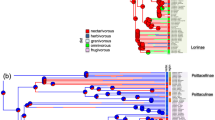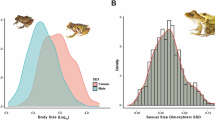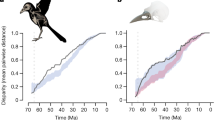Abstract
I recently attempted to investigate interspecific patterns in ecological traits of Australian snakes using univariate statistical techniques (Shine 1994), but high intercorrelations among variables (especially with mean adult body size) made it difficult to interpret the observed patterns. In the present paper, I attempt to tease apart causal factors using multivariate (path) analysis on the same data set (103 species, based on dissection of >22000 museum specimens). Two separate path analyses were conducted: one that treated each species as an independent unit (and thus, ignored phylogeny) and the other based on independent phylogenetic contrasts. Path coefficients from the two types of analyses were similar in magnitude, and highly correlated with each other, suggesting that most interspecific patterns among traits may reflect functional association rather than phylogenetic conservatism. Path analysis showed that indirect effects of one variable upon another (i.e., mediated via other traits) were often stronger than direct effects. Thus, even when two variables appeared to be uncorrelated in the univariate analysis, this apparent lack of relationship sometimes masked strong but conflicting indirect effects. For example, a tradeoff between clutch size and offspring size tends to mask the direct effect of mean adult body size on clutch size. Path analysis may also suggest original causal hypotheses. For example, interspecific allometry of sexual size dimorphism (as seen in Australian snakes, and many other animal groups) may result from a strong effect of another allometrically-tied trait (offspring size) on growth trajectories of females.
Similar content being viewed by others
References
Andersson M (1994) Sexual selection. Princeton University Press, Princeton
Andrews RM (1982) Patterns of growth in reptiles. In: Gans C, Pough FH (eds) Biology of the Reptilia, vol. 13. Academic Press, New York, pp 273–320
Harvey PH, Pagel MD (1991) The comparative method in evolutionary biology (Oxford studies in ecology and evolution). Oxford University Press, Oxford
King RB (1993) Determinants of offspring number and size in the brown snake, Storeria dekayi. J Herpetol 27:175–185
Kingsolver JG, Schemske DW (1991) Path analyses of selection. Trends Ecol Evol 6:277–280
Lovich JE, Gibbons JW (1992) A review of techniques for quantifying sexual size dimorphism. Growth Dev Aging 56:269–281
Madsen T, Shine R (1994) Costs of reproduction influence the evolution of sexual size dimorphism in snakes. Evolution 48: 1389–1397
Nussbaum RA (1985) The evolution of parental care in salamanders. Misc Publ Mus Zool Univ Mich 169:1–50
Reiss MJ (1989) The allometry of growth and reproduction. Cambridge University Press, Cambridge
Seigel RA (1993) Summary: future research on snakes, or how to combat “lizard envy”. In: Seigel RA, Collins JT (eds) Snakes: ecology and behavior. McGraw-Hill, New York, pp 395–402
Seigel RA, Ford NB (1987) Reproductive ecology. In: Seigel RA, Collins JT, Novak SS (eds) Snakes: ecology and evolutionary biology. Macmillan, New York, pp 210–252
Shine R (1989) Constraints, allometry and adaptation: food habits and reproductive biology of Australian brownsnakes (Psedonaja, Elapidae). Herpetologica 45:195–207
Shine R (1990) Proximate determinants of sexual differences in adult body size. Am Nat 135:278–283
Shine R (1991) Intersexual dietary divergence and the evolution of sexual dimorphism in snakes. Am Nat 138:103–122
Shine R (1993) Sexual dimorphism. In: Seigel RA, Collins JT (eds) Snakes: ecology and behavior. McGraw-Hill, New York, pp 49–86
Shine R (1994a) Allometric patterns in the ecology of Australian snakes. Copeia 1994:851–867
Sine R (1994b) Sexual size dimorphism in snakes revisited. Copeia 1994: 326–246
Shine R, Charnov EL (1992) Patterns of survival, growth and maturation in snakes and lizards. Am Nat 139:1257–1269
Shine R, Slip DJ (1990) Biological aspects of the adaptive radiation of Australasian pythons (Serpentes: Boidae). Herpetelogica 46:283–290
Weatherhead PJ, Teather KL (1994) Sexual size dimorphism and egg-size allometry in birds. Evolution 48:671–678
Author information
Authors and Affiliations
Rights and permissions
About this article
Cite this article
Shine, R. Life-history evolution in Australian snakes: a path analysis. Oecologia 107, 484–489 (1996). https://doi.org/10.1007/BF00333939
Received:
Accepted:
Issue Date:
DOI: https://doi.org/10.1007/BF00333939




